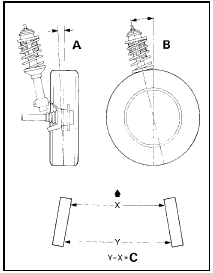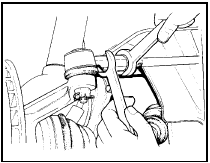Steering angles and wheel alignment
1 Accurate front wheel alignment is essential to good steering and for even tyre wear.
Before considering the steering angles, check that the tyres are correctly inflated, that the roadwheels are not buckled, the hub bearings are not worn or incorrectly adjusted and that the steering linkage is in good order.
2 Wheel alignment consists of four factors (see illustration):

27.2 Wheel alignment diagram
A Camber
B Castor
C Toe setting
Camber is the angle at which the roadwheels are set from the vertical when viewed from the front or rear of the vehicle. Positive camber is the angle (in degrees) that the wheels are tilted outwards at the top from the vertical.
Castor is the angle between the steering axis and a vertical line when viewed from each side of the vehicle. Positive castor is indicated when the steering axis is inclined towards the rear of the vehicle at its upper end.
Steering axis inclination is the angle, when viewed from the front or rear of the vehicle, between the vertical and an imaginary line drawn between the upper and lower suspension swivel balljoints or upper and lower strut mountings.
Toe is the amount by which the distance between the front inside edges of the roadwheel rims differs from that between the rear inside edges. If the distance at the front is less than that at the rear, the wheels are said to toe-in. If the distance at the front inside edges is greater than that at the rear, the wheels toe-out.
3 Due to the need for precision gauges to measure the small angles of the steering and suspension settings, it is preferable to leave this work to your dealer. Camber and castor angles are set in production and are not adjustable. If these angles are ever checked and found to be outside specification then either the suspension components are damaged or distorted, or wear has occurred in the bushes at the attachment points.
4 If you wish to check the toe setting yourself, first make sure that the lengths of both tie-rods are equal when the steering is in the straightahead position. This can be measured reasonably accurately by counting the number of exposed threads on the tie-rod adjacent to the balljoint assembly (refer to Section 23).
5 Adjust, if necessary, by releasing the locknut from the balljoint assembly and the clamp at the small end of the bellows (see illustration).

27.5 Slackening tie-rod balljoint locknut
for toe setting adjustment
6 Obtain a tracking gauge. These are available in various forms from accessory stores, or one can be fabricated from a length of steel tubing, suitably cranked to clear the sump and bellhousing, and having a setscrew and locknut at one end.
7 With the gauge, measure the distance between the two inner rims of the roadwheels (at hub height) at the rear of the wheel. Push the vehicle forward to rotate the wheel through 180° (half a turn) and measure the distance between the wheel inner rims, again at hub height, at the front of the wheel. This last measurement should differ from the first one by the specified toe-in/toe-out (see “Specifications”).
8 Where the toe setting is found to be incorrect, release the tie-rod balljoint locknuts and turn the tie-rods by an equal amount.
Only turn them through a quarter turn at a time before re-checking the alignment. Do not grip the threaded part of the tie-rod during adjustment and make sure that the bellows outboard clip is released, otherwise the bellows will twist as the tie-rod is rotated.
When each tie-rod is viewed from the rack housing, turning the rods clockwise will increase the toe-out. Always turn the tie-rods in the same direction when viewed from the centre of the vehicle, otherwise they will become unequal in length. This would cause the steering wheel spoke alignment to alter and also cause problems on turning with tyre scrubbing.
9 On completion of adjustment, tighten the tie-rod balljoint locknuts without altering the setting of the tie-rods. Hold the balljoint assembly at the mid-point of its arc of travel (flats are provided on it for a spanner) while the locknuts are tightened.
10 Finally, tighten the bellows clamps.
11 For rear wheel alignment refer to Section 19.
See also:
Major operations requiring engine removal
The following work can only be carried out
after removal of the engine from the car:
a) Crankshaft main bearings - renewal.
b) Crankshaft - removal and refitting.
c) Flywheel - removal and refitti ...
Facia - removal and refitting
Pre-1986 models
Removal
1 Disconnect the battery negative lead.
2 Remove the under-dash cover panels.
3 Refer to Chapter 10 and remove the
steering column assembly.
4 Refer to Chapter 12 and rem ...
Radio/cassette player and graphic equaliser - removal and
refitting
Note: The information in this Section applies to
Ford original equipment fitment components.
Radio
Early models
Removal
1 Disconnect the battery.
2 Pull off the control knobs, the tuning knob
s ...
